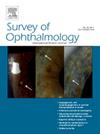Extracellular vesicles in dry eye disease and Sjögren’s syndrome: A systematic review on their diagnostic and therapeutic role
IF 5.1
2区 医学
Q1 OPHTHALMOLOGY
引用次数: 0
Abstract
Extracellular vesicles (EVs), defined as membrane-bound vesicles released from all cells, are being explored for their diagnostic and therapeutic role in dry eye disease (DED). We systematically shortlisted 32 articles on the role of EVs in diagnosing and treating DED. We cover the progress in the last 2 decades on the classification and isolation of EVs and their role in DED. The diagnostic predictability of exosomes was evaluated in Sjögren syndrome (SS) patients' tears, plasma, and saliva, where upregulation of inflammatory proteins was reported uniformly across studies. Also, we evaluate the therapeutic effects of MSC-derived EVs in in vitro and in vivo studies of SS and DED mouse models. A significant response occurs at a functional level with improved tear production and saliva flow rate and at a cellular level with reduced lymphocyte infiltration, improved corneal structural integrity, decreased epithelial cell apoptosis, and dampening of the inflammatory cytokine response. The proposed mechanisms of EV action include PD-L1, PRDM, NLRP-3, and Nf-kb pathways, and an increase in M2 macrophage phenotype. Current use of exosomes in DED is limited due to their cumbersome isolation techniqus. Further research on human subjects is needed, in addition to optimizing exosome isolation and delivery methods.
细胞外囊泡在干眼病和干燥综合征中的诊断和治疗作用的系统综述。
细胞外囊泡(EVs)被定义为从所有细胞中释放的膜结合囊泡,正在探索其在干眼病(DED)中的诊断和治疗作用。我们系统地筛选了32篇关于ev在诊断和治疗DED中的作用的文章。本文系统综述了近20年来ev的分类、分离及其在DED中的作用。外泌体的诊断预测性在干燥综合征(SS)患者的眼泪、血浆和唾液中进行了评估,在这些研究中,炎症蛋白的上调被一致报道。此外,在SS和DED小鼠模型的体外和体内研究中,评估了msc来源的ev的治疗效果。一个显著的反应发生在功能水平上,泪液生成和唾液流率提高;在细胞水平上,淋巴细胞浸润减少,角膜结构完整性改善,上皮细胞凋亡减少,炎症细胞因子反应减弱。EV的作用机制包括PD-L1、PRDM、NLRP-3和Nf-kb途径以及M2巨噬细胞表型的增加。目前外泌体在DED中的使用由于其繁琐的分离而受到限制。除了优化外泌体的分离和递送方法外,还需要对人体进行进一步的研究。
本文章由计算机程序翻译,如有差异,请以英文原文为准。
求助全文
约1分钟内获得全文
求助全文
来源期刊

Survey of ophthalmology
医学-眼科学
CiteScore
10.30
自引率
2.00%
发文量
138
审稿时长
14.8 weeks
期刊介绍:
Survey of Ophthalmology is a clinically oriented review journal designed to keep ophthalmologists up to date. Comprehensive major review articles, written by experts and stringently refereed, integrate the literature on subjects selected for their clinical importance. Survey also includes feature articles, section reviews, book reviews, and abstracts.
 求助内容:
求助内容: 应助结果提醒方式:
应助结果提醒方式:


